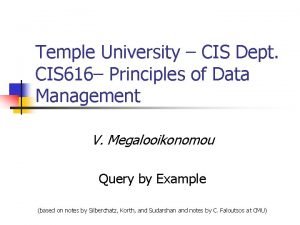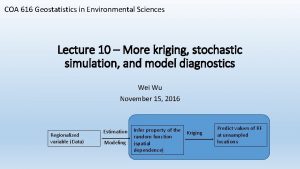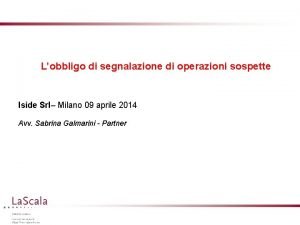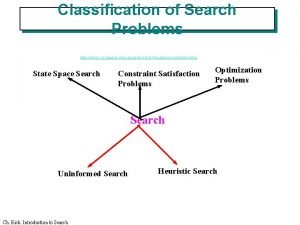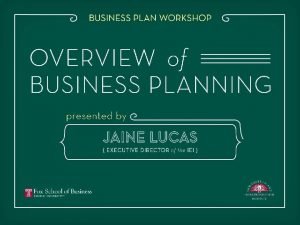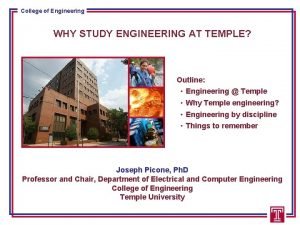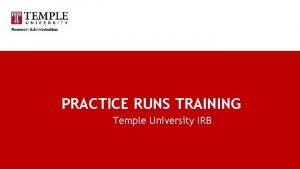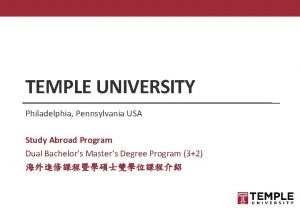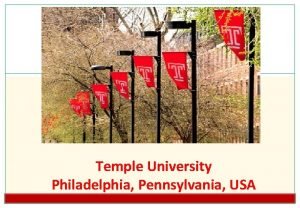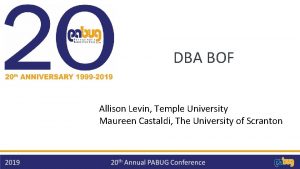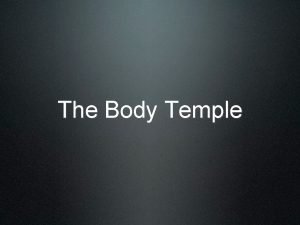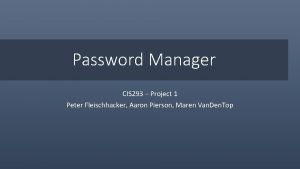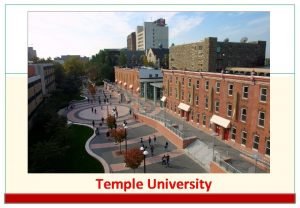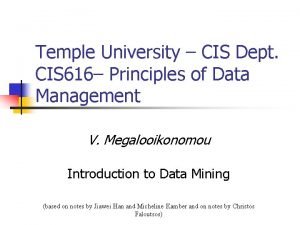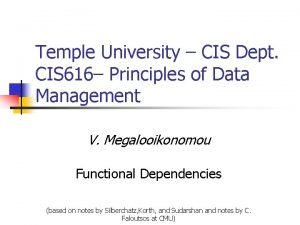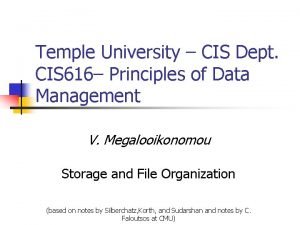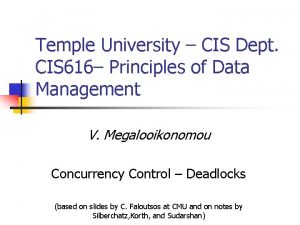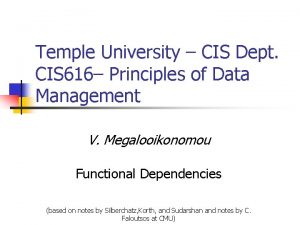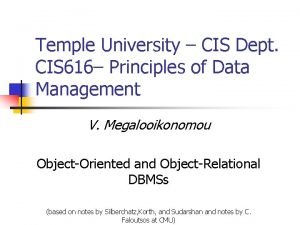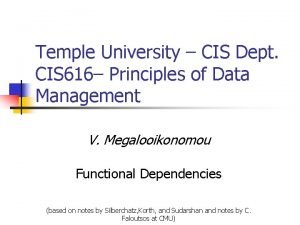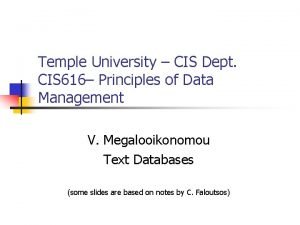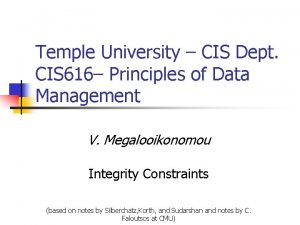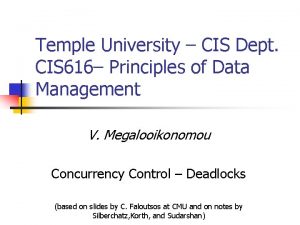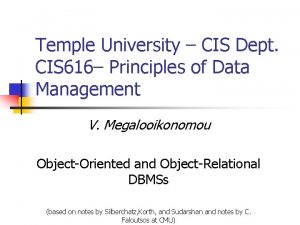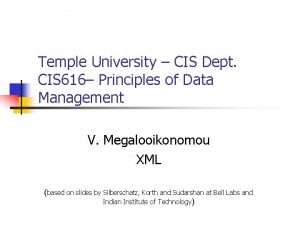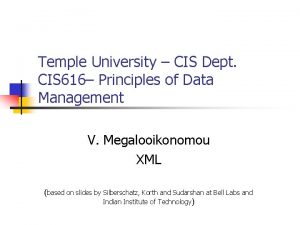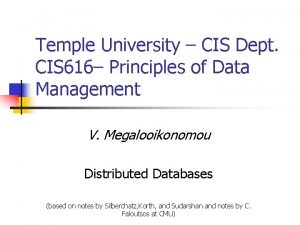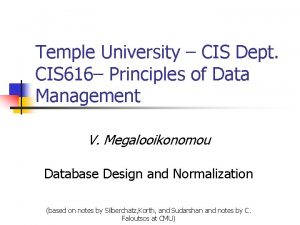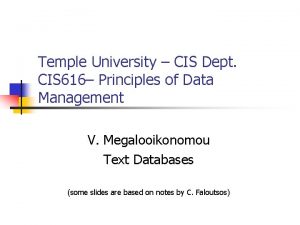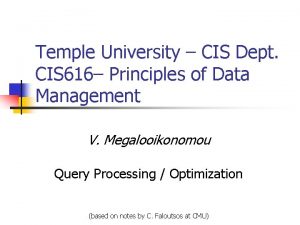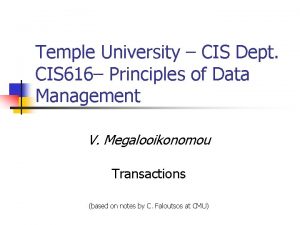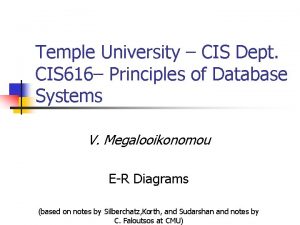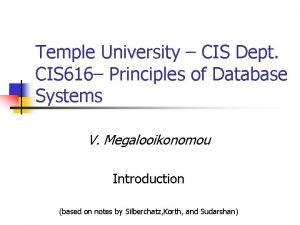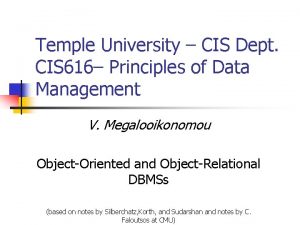Temple University CIS Dept CIS 616 Principles of


































- Slides: 34

Temple University – CIS Dept. CIS 616– Principles of Data Management V. Megalooikonomou Object-Oriented and Object-Relational DBMSs (based on notes by Silberchatz, Korth, and Sudarshan and notes by C. Faloutsos at CMU)

Detailed outline n n OO DBMSs OR DBMS n n n complex data types inheritance UDFs ORACLE-specific extensions Conclusions

Why more than RDBMSs? n n RDBMS: tuples, of numbers + strings What apps need only those?

Why more than RDBMSs? n n RDBMS: tuples, of numbers + strings What apps need only those? n n n Banks Airlines Retailer stores. . . Q: Other apps, with more req’s?

Why more than RDBMS’s n n Q: Other apps, with more req’s? A: n n n text multimedia; financial apps/forecasting Geographic Inf. Sys. CAD/CAM Network management

Their specs? n n n complex objects (sets/vectors) inheritance new data types (image, video, . . . ) and user defined functions (UDFs)

Two solutions: n n Object Oriented DBMSs Object Relational DBMSs

OO DBMS n n roughly, ‘C++’ with persistence commercial systems: n n O 2; Object. Store; Objectivity Object Database Management Group (ODMG): defined standards BUT: OODBMS have small market share Hence: OR-DBMSs

OR DBMSs traditional DBMS with attempts to provide n enriched data types n user defined data types n support for large / complex objects n inheritance

SQL-3 proposed extensions n n n complex types (sets, lists, multisets) inheritance (IS-A hierarchies) User Defined Functions (UDFs)

Complex types e. g. , create type My. Date ( day decimal(2), month char(3), year decimal (4) );

Complex types e. g. , Row Types: create row type Doc ( callnum varchar 2(10), title char(20), authors list (varchar 2(20)) ); create table document of type Doc;

Complex types DML - insertions: insert into document values (‘QA 123. 45’, ‘DB systems’, set(‘Smith’, ‘Johnson’) );

Inheritance single inheritance: create type Person ( ssn varchar 2(10), name char(20)); create type Student (major varchar 2(5)) under Person;

Inheritance multiple inheritance: create type Teacher ( salary integer) under Person; create type TA under Student, Teacher;

Inheritance multiple inheritance: constraints: one TA record corresponds to exactly one ‘Teacher’ and ‘Student’ record insertions/deletions/updates: appropriately propagated.

Object Ids and references can define ‘object ids’ for each object, and use them, effectively as pointers.

Query language extensions find titles, (co-)authored by ‘Smith’ (recall: ) create row type Doc ( callnum varchar 2(10), title char(20), authors list (varchar 2(20)) ); create table document of type Doc;

Query language extensions select title from document where ‘Smith’ in authors;

SQL-3 proposed extensions overview n n n complex types (sets, lists, multisets) inheritance (IS-A hierarchies) User Defined Functions (UDFs)

UDFs create function author-count (adoc document) returns integer as select count (authors) from adoc; select title from document d where author-count(d) > 1

UDFs: stay within the DBMS, for everybody to use!

Detailed outline n n OO DBMSs OR DBMS n n n complex data types inheritance UDFs ORACLE-specific extensions Conclusions

ORACLE-specific n n Large objects PL/SQL and UDFs

ORACLE-specific n n Large objects, e. g. , video, images, 3 d. MRI scans new data types:

ORACLE-specific n n Large objects, e. g. , video, images, 3 d. MRI scans new data types: LOB (=Large OBject) n n BLOB: (up to 4 Gb; binary: jpeg, mpeg, . . . ) CLOB: (up to 2 Gb; character: english text) NCLOB: (. . . ; multi-byte characters) (LONG: similar, for backwards compatibility)

ORACLE-specific n n stored procedures PL/SQL: a ‘C’-like language n n too large to describe here… example of a stored procedure:

ORACLE-specific SQL> create or replace procedure del-st-rec (s-id number) as begin delete from student where s-id = ssn; end del-st-rec; SQL> execute del-st-rec ( 123 );

Illustra Informix IBM’s Informix Dynamic Server Illustra n Informix Dynamic Server (Universal Data Option) n IBM DB 2 Universal Database – Informix Product family n

Illustra Informix IBM’s Informix Dynamic Server n Datablades technology - extensions for specific data domains n n n n Image Text Geodetic Spatial Time series Video Web

Informix - Sample SQL queries n n n n COMPUTE VOLUME OF A GIVEN STRUCTURE return volume((select unique image from structures where side='Left' and atlas='Brodmann' and name='17')) ; DISPLAY GIF OF ALL LESIONS SUMMED UP insert into temp_image_1 values(permanent(map_image(sum_images(( select image from patient_images where image. description='All Lesions')), 'redgreenscale'))) ; select TS. Slice. No, slice(TS. Slice. No, overlay. image): : GIF as Lesion. Density from Talairach. Slices TS, temp_image_1 overlay order by Slice. No ;

Detailed outline n n OO DBMSs OR DBMS n n n complex data types inheritance UDFs ORACLE-specific extensions Informix Conclusions

Conclusions n OO and OR DBMS strive for n n complex data types inheritance UDFs OR DBMSs: overwhelming market share (why? )

Conclusions n OR DBMSs: overwhelming market share (why? ) n n n SQL is more standardized than OO query languages legacy data are in SQL more SQL programmers are available
 Temple university cis
Temple university cis Erth 616
Erth 616 Iter segnalazione operazione sospetta schema
Iter segnalazione operazione sospetta schema Cis temple
Cis temple Temple university entrepreneurship
Temple university entrepreneurship Engineering temple run
Engineering temple run Temple irb forms
Temple irb forms Temple disability services
Temple disability services Study abroad application temple
Study abroad application temple Temple university ielp
Temple university ielp Temple university writing center
Temple university writing center Isss temple
Isss temple Vraj temple philadelphia
Vraj temple philadelphia Oneness university temple
Oneness university temple Aarononpc
Aarononpc Temple university undergraduate bulletin
Temple university undergraduate bulletin Dept nmr spectroscopy
Dept nmr spectroscopy Florida department of agriculture and consumer services
Florida department of agriculture and consumer services Finance department organizational chart
Finance department organizational chart Worcester electrical inspector
Worcester electrical inspector Dept. name of organization (of affiliation)
Dept. name of organization (of affiliation) Mn dept of education
Mn dept of education Department of finance and administration
Department of finance and administration Dept. name of organization (of affiliation)
Dept. name of organization (of affiliation) Ohio dept of dd
Ohio dept of dd Poster affiliation
Poster affiliation Vaginal dept
Vaginal dept Gome dept
Gome dept Gome dept
Gome dept Horizontal
Horizontal Gome dept
Gome dept Hoe dept
Hoe dept Firefighter oral interview questions
Firefighter oral interview questions Maine dept of agriculture
Maine dept of agriculture Dept of education
Dept of education
